Neuroprotective effects of nonfeminizing estrogens in retinal photoreceptor neurons
- PMID: 22700711
- PMCID: PMC4625827
- DOI: 10.1167/iovs.12-9517
Neuroprotective effects of nonfeminizing estrogens in retinal photoreceptor neurons
Abstract
Purpose: Retinal diseases such as macular degeneration and glaucoma are disorders that target specific retinal neurons that can ultimately lead to vision loss. Under these conditions and pathologies, retinal neurons can die via apoptosis that may be due to increased oxidative stress. The neuroprotective effects of 17β-estradiol (E2) and three synthetic nonfeminizing estrogen analogs (ZYC-26, ZYC-23, and ZYC-3) were investigated to examine their abilities to protect retinal neurons against glutamate toxicity.
Methods: Using an in vitro model of glutamate-induced cell death in 661W cells, a mouse cone photoreceptor cell line, shown to express both estrogen receptors (ERs) via immunoblotting, was pretreated with E2 and its analogs and cell viability were assessed.
Results: It was observed that E2 and estrogen analogs, ZYC-26 and ZYC-3, were protective against a 5 mM glutamate insult in 661W cells. The neuroprotective abilities of ZYC-26 and ZYC-3 were autonomous of estrogen receptor-α (ERα) and ERβ demonstrated by their ability to protect in the presence of ICI 182780, a pan-ER antagonist with a high affinity for the estrogen receptor. Treatment with PPT and DPN, ERα- and ERβ-specific agonists, respectively, did not protect the 661W cells from the glutamate insult. Studying the membrane ER (mER) or GPR30 did show that activation of the receptor by G1 protected the retinal neuron from insult, whereas G15, an antagonist of the mER was not able to antagonize the protection previously seen.
Conclusions: These data demonstrate that nonfeminizing estrogens may emerge as useful compounds for neuroprotection of retinal cells.
Conflict of interest statement
Disclosure:
Figures







Similar articles
-
Role of nonfeminizing estrogen analogues in neuroprotection of rat retinal ganglion cells against glutamate-induced cytotoxicity.Free Radic Biol Med. 2005 May 1;38(9):1152-63. doi: 10.1016/j.freeradbiomed.2004.12.007. Free Radic Biol Med. 2005. PMID: 15808412
-
Estrogen receptor alpha and beta differentially regulate intracellular Ca(2+) dynamics leading to ERK phosphorylation and estrogen neuroprotection in hippocampal neurons.Brain Res. 2007 Oct 3;1172:48-59. doi: 10.1016/j.brainres.2007.06.092. Epub 2007 Jul 31. Brain Res. 2007. PMID: 17803971
-
Neuroprotective properties of selective estrogen receptor agonists in cultured neurons.Brain Res. 2005 May 31;1045(1-2):217-23. doi: 10.1016/j.brainres.2005.03.032. Epub 2005 Apr 20. Brain Res. 2005. PMID: 15910780
-
Evidence-based neuroprotective potential of nonfeminizing estrogens: In vitro and in vivo studies.Eur J Neurosci. 2024 Oct;60(8):6046-6056. doi: 10.1111/ejn.16512. Epub 2024 Sep 19. Eur J Neurosci. 2024. PMID: 39297873 Review.
-
Contribution of estrogen receptors alpha and beta to the effects of estradiol in the brain.J Steroid Biochem Mol Biol. 2008 Feb;108(3-5):327-38. doi: 10.1016/j.jsbmb.2007.09.011. Epub 2007 Sep 7. J Steroid Biochem Mol Biol. 2008. PMID: 17936613 Review.
Cited by
-
Cell surface translocation of annexin A2 facilitates glutamate-induced extracellular proteolysis.J Biol Chem. 2014 Jun 6;289(23):15915-26. doi: 10.1074/jbc.M113.511550. Epub 2014 Apr 17. J Biol Chem. 2014. PMID: 24742684 Free PMC article.
-
Sex Hormones and Optic Nerve Disorders: A Review.Front Neurosci. 2019 Feb 11;13:57. doi: 10.3389/fnins.2019.00057. eCollection 2019. Front Neurosci. 2019. PMID: 30804741 Free PMC article. Review.
-
Impact of aromatase absence on murine intraocular pressure and retinal ganglion cells.Sci Rep. 2018 Feb 19;8(1):3280. doi: 10.1038/s41598-018-21475-x. Sci Rep. 2018. PMID: 29459742 Free PMC article.
-
Etiology of Idiopathic Macular Holes in the Light of Estrogen Hormone.Curr Issues Mol Biol. 2023 Jul 29;45(8):6339-6351. doi: 10.3390/cimb45080400. Curr Issues Mol Biol. 2023. PMID: 37623219 Free PMC article. Review.
-
Gonadal Hormones and Retinal Disorders: A Review.Front Endocrinol (Lausanne). 2018 Mar 2;9:66. doi: 10.3389/fendo.2018.00066. eCollection 2018. Front Endocrinol (Lausanne). 2018. PMID: 29551993 Free PMC article. Review.
References
-
- Murphy TH, Miyamoto M, Sastre A, Schnaar RL, Coyle JT. Glutamate toxicity in a neuronal cell line involves inhibition of cystine transport leading to oxidative stress. Neuron. 1989; 2: 1547– 1558. - PubMed
-
- Bailey TA, Kanuga N, Romero IA, Greenwood J, Luthert PJ, Cheetham ME. Oxidative stress affects the junctional integrity of retinal pigment epithelial cells. Invest Ophthalmol Vis Sci. 2004;. 45: 675– 684. - PubMed
-
- Gutteridge JM, Halliwell B. Comments on review of Free Radicals in Biology and Medicine, second edition, by Halliwell Barry, Gutteridge John M. C. Free Radic Biol Med. 1992;. 12: 93– 95. - PubMed
-
- Chance B, Sies H, Boveris A. Hydroperoxide metabolism in mammalian organs. Physiol Rev. 1979;. 59: 527– 605. - PubMed
Publication types
MeSH terms
Substances
Grants and funding
LinkOut - more resources
Full Text Sources
Other Literature Sources
Miscellaneous

